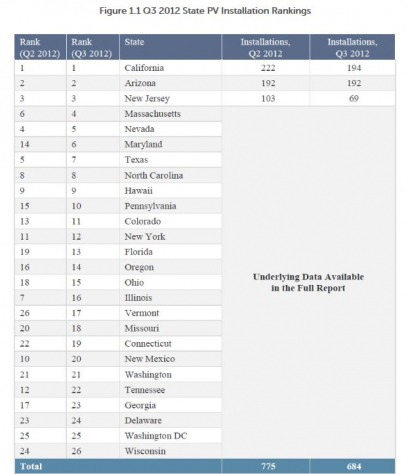
The quarter marked the third largest on record for the US PV industry and raised the total installed capacity through the first three quarters of the year to 1,992 MW — already surpassing 2011’s annual total of 1,885 MW.
Cumulatively, there are now 5.9 GW of PV, which converts sunlight directly to electricity, operating in the US from more than 271,000 installations.
Combined with concentrating solar power facilities (CSP), which convert the sun’s heat to electricity, there are more than 6.4 GW of solar electric capacity installed in the U.S., enough to power more than one million average American households.
The third quarter featured strong growth in distributed generation (DG) markets; the residential PV sector installed more than 118 MW, an all-time high for a quarter, while the commercial market (including governmental and institutional facilities) hit 257 MW, rising 24 percent above last quarter.
In addition to solid growth nationally, Colorado, Florida, Maryland, Massachusetts, and Pennsylvania saw growth of 5 MW or greater compared to the previous quarter. Behind Maryland, Massachusetts saw the greatest quarter-over-quarter increase, up from 25 MW in Q2 2012 to 40 MW this quarter.
All Massachusetts installations in Q3 2012 came from the commercial and residential sectors, boosted by the expansion of net metering allowances and an influx of national retailers that offer leasing and other innovative “third-party” ownership models. For the quarter, the top ranked states were California, Arizona, New Jersey, Massachusetts and Nevada. As of Sept. 30, top states for total cumulative installed solar electric capacity were: California, New Jersey, Arizona, Nevada and Colorado.
The GTM and SEIA research teams expect third-party leased PV systems to remain a hot option in the market for homeowners into 2013 and beyond. During this quarter, residential PV markets in Arizona, Colorado, California, and Massachusetts saw third-party systems range from 57 to 91 percent of total residential system installations.
“While Q3 2012 was remarkable for the U.S. PV market, it is just the opening act for what we expect to see in Q4,” said Shayle Kann, vice president of research at GTM. “We forecast more than 1.2 GW of PV to be installed next quarter on the back of developers who are pushing to meet year-end deadlines in both the utility and commercial segments. We also expect to see the residential PV market post another record number in Q4, as third-party residential installers gain more traction in mature, cost-effective markets.”
Historically, Q4 has been the strongest for PV installations in the US In 2010 and 2011, Q4 represented 41 percent and 42 percent of annual installations, respectively.
US Solar Market Insight forecasts a similar Q4 bump in 2012 with approximately 1,200 MW to be installed. That would not only account for 38 percent of this year’s forecasted total, but would be the largest single quarter on record for the US PV market by far.
SEIA and GTM Research expect 2012 growth to top 70 percent with a record 3.2 GW of solar installed – enough to power more than half a million average US homes.
“This quarter’s record residential growth shows the power of innovation in the U.S. solar industry,” said Rhone Resch, president and CEO of SEIA. “With costs continuing to come down and new financing options, solar energy is affordable today for more families, businesses, utilities, and the military. Thanks to smart long-term policy, the solar industry is growing to meet the challenge of putting Americans back to work and helping to grow both our nation’s economy and our clean energy portfolio.”
System prices for PV projects in the US continued their downward trajectory in third quarter 2012. Average residential system prices dropped quarter-over-quarter from $5.45 per watt to $5.21 per watt nationally while average non-residential prices declined 15 cents per watt, falling to $4.18. Average utility system prices, which are currently at $2.40 per watt, continue to see the greatest reduction in prices of the three market segments covered, falling by 30 percent since third quarter last year.
Commercial installations grew 24 percent in third quarter over second quarter in 2012, led by notable growth in California and Massachusetts; a strong fourth quarter is also expected for this market.
"The data coming out of the U.S. Solar Market Insight reports mirrors what we are seeing as an owner of commercial rooftop solar projects in the U.S.," said Mike Ward, U.S. president, IKEA. “We completed 23 solar installations in 2012 and next year, we plan to deploy at least 7.5 megawatts of solar PV at five more IKEA locations across the U.S. Having strategic data and understanding trends in each state market is crucial for us to achieve our goal of having 90 percent of our facilities powered by solar and reaching a total generating capacity of 38 megawatts.”
For additional information:
Canadians have done tests to see if solar power is more competitive on the free market if oil prices are de-regulated. As a test case, they took the a sports complex with indoor heated swimming pools. They ran the facility on oil and conventional power and then switched to an all solar power operated plant. They found significant costs savings in operating the facility on solar.

